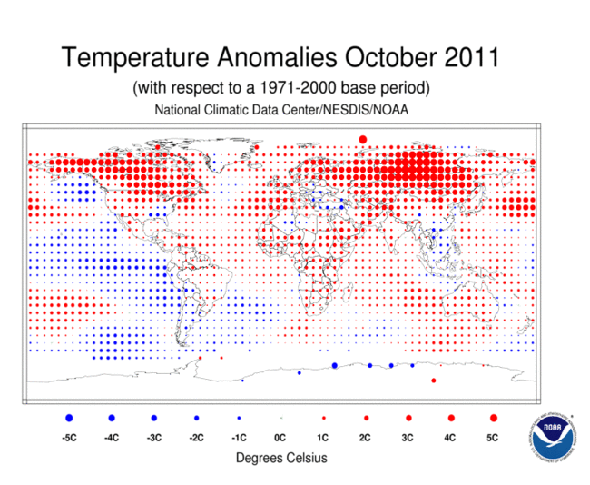According to the National Oceanic and Atmospheric Administration’s latest analysis of global temperatures, October 2011 was the 8th warmest October ever recorded since 1880.

NOAA’s National Climatic Data Centre provide a series of reports as part of their services to the government, business and community leaders, which have been helping everybody keep a track of escalating temperatures.
In addition to being the 8th warmest October since record keeping began back in 1880, NOAA also found that Arctic sea ice extent was the second smallest extent on record for October, measuring in at 23.5 percent below the average.
On top of all of that, La Niña conditions strengthened during October, and are expected to continue through the Northern Hemisphere’s winter.
La Niña was barely down for a few months before reappearing, and it’s last appearance resulted in the now infamous Snowmageddon.
Here are a few more highlights from the report:
Global temperature highlights for the month of October
- The combined global land and ocean average surface temperature for October 2011 was the eighth warmest on record at 58.14 F (14.58 C), which is 1.04 F (0.58 C) above the 20th century average of 57.1 F (14.0 C). The margin of error associated with this temperature is +/- 0.13 F (0.07 C).
- The global land surface temperature was 1.98 F (1.10 C) above the 20th century average of 48.7 F (9.3 C), making this the 2nd warmest October on record. The margin of error is +/- 0.20 F (0.11 C). Warmer-than-average conditions occurred across Alaska, Canada, most of Europe and Russia, and Mongolia. Cooler-than-average regions included the southeastern United States, most of southern and western South America, parts of Algeria and Libya, part of Eastern Europe, and far southeast Asia.
- The global ocean surface temperature was 0.70 F (0.39 C) above the 20th century average of 60.6 F (15.9 C), making it the 11th warmest October on record. The margin of error is +/- 0.07 F (0.04 C). The warmth was most pronounced across the north central and northwest Pacific, the northeast Atlantic, and portions of the mid-latitude Southern oceans.
- The United Kingdom marked its warmest October since 2006 and eighth warmest in the last 100 years, at 3.6 F (2.0 C) above the 1971–2000 average.
- Several locations in Argentina experienced their coolest October in five decades

Global temperature highlights: Year to date
- The combined global land and ocean average surface temperature for the January – October period was 0.95 F (0.53 C) above the 20th century average of 57.4 F (14.0 C), making it the 10th warmest such period on record. The margin of error is +/- 0.16 F (0.09 C).
- The January – October worldwide land surface temperature was 1.53 F (0.85 C) above the 20th century average, the sixth warmest such period on record. The margin of error is +/- 0.34 F (0.19 C). The global ocean surface temperature for the year to date was 0.74 F (0.41 C) above the 20th century average and was the 12th warmest such period on record. The margin of error is +/-0.07 F (0.04 C).
- La Niña conditions strengthened during October 2011. According to NOAA’s Climate Prediction Center, La Niña is expected to continue through the Northern Hemisphere winter 2011/2012.
- Monthly rainfall across Spain was 35 percent below average, the driest October since 1998.
Polar Sea Ice and Precipitation Highlights - The average Arctic sea ice extent during October was 23.5 percent below average, ranking as the second smallest October extent since satellite records began in 1979. The extent was 846,000 square miles (2.19 million square kilometers) below average and 127,000 square miles (330,000 square kilometers) larger than the record low October extent set in 2007.
- On the opposite pole, the October Antarctic monthly average ice extent was 1.2 percent above the 1979–2000 average, the 12th largest on record.
- Despite a record-breaking snowstorm in the US Northeast, Northern Hemisphere snow cover extent during October was below average, and ranked as the 15th smallest October snow cover extent in the 44-year period of record. The North America and Eurasian land areas both had below-average snow cover during the month.
Source: NOAA

